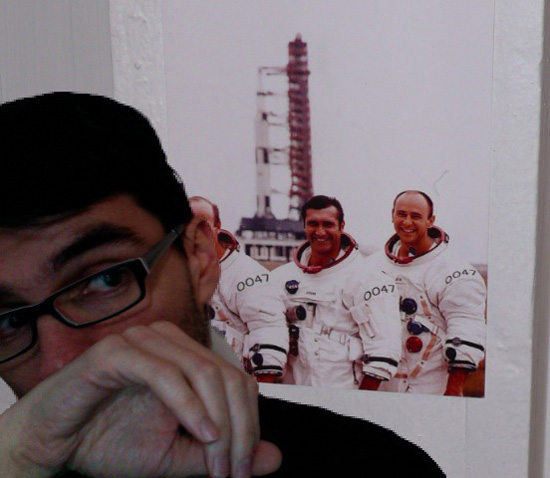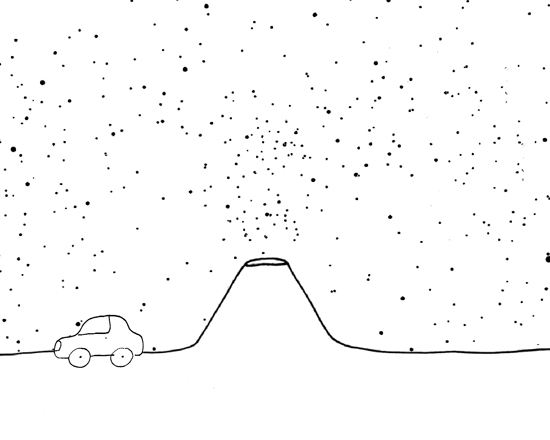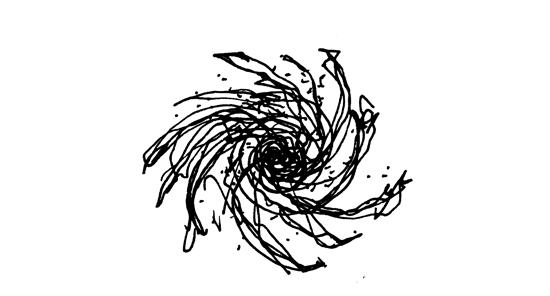
Tekst: Anne Marthe Dyvi
It takes time to understand an art institution. And parts of the art institution tend to be a bit anonymous. For instance the Fellow Researchers. What do they do?
I know of the description done by the institution, and by The National Norwegian Artistic Research Fellowships Programme. But I wanted to know what it is like from the inside.
What is artistic research? What does a Fellow Researcher do?
Pedro Gómez-Egaña is a researcher in art at Bergen National Academy of the Arts, and he has kindly answered some of my questions.
How is the everyday for a researcher? And how does it differ from your everyday as an artist?
It isn’t very different to what I’ve been doing for some years now. My practice often seems to have an academic setting, and, even when I am not a student or researcher, I seem to try to establish some sort of a reflective environment from which to operate. But then again, I think that there is generally a misconception when it comes to what research in the arts means. People think that being a researcher means that you are reading and writing all the time, doing things different to making art itself. This tension between a student’s idea of what art-making is and his/her idea of what research is seems to be present all the time in academic environments lately.
When this question comes up I tend to focus on how things like «text» or «reflection» appear within my practice already, so that research is revealed rather than summoned. So that I don’t feel like I have to take some model and adapt my process to it.
How do you see the idea of research being presented by this programme?
The thing with “research” is that the term appeared from an academic institution standpoint, not necessarily from an artistic one. Research has become a key way for art to be part of the university universe. It is a tool that provides accountability, a way for artistic process to be accepted as a tangible product of knowledge, and to make it work with the mechanics and bureaucracies of an institution.In a way this is cool because it means that artists may have other ways of finding sources and resources (an academic status often leads to better pay when you teach, and/or more project funding, etc), but I do think that it becomes problematic when research is presented as the only way to legitimise art practices in the Academy. That art is only of a high standard if it is encapsulated in some sort of research context. It’s a similar problem with the gallery-based art market, there is this absurd assumption that selling a lot means that you are a good artist.
In any case, each research programme has its own particularities. The one I am in now uses the notion of Critical Reflection as one of its main paradigms. I translate that to an exercise in which I evidence my process and the connections that appear around and through it. I write about it, I write in my work a lot anyway so it’s not so different to just doing my thing. The programme also has strategies for motivating us to reflect and share the state of our work, like asking us to do presentations. There is a main platform for this, a seminar where we give presentations and engage in discussions with out colleagues.

Who is your audience at the seminars and presentations organised by the research programme? And how do they relate to your work?
There are bi-annual seminars with everyone who is a part of the programme: the fellows from all the different disciplines (music, theatre, arts, etc), their supervisors, the steering committee of the programme and some guests. It’s a very nice idea to bring a lot of people together under the umbrella of an interdisciplinary research programme, which was one of the reasons that I was attracted to this programme. But at the same time, there is something about the way that these seminars get executed that I don’t find so useful. I mean, it is extremely well organised, and it is very generous in terms of the idea of concentrating everyone in a place where they can focus. But both times I’ve been to this seminar I end up with a feeling that nothing was really covered. The time is so limited and the agenda is so full that it is impossible to reach any substantial depth with any of the projects. It is more or less based on an immediate response to someone’s presentation. And since art practices are so layered and complicated, and since research projects are so specific, it is hard to assume that 45 minutes will allow for any kind of discussion that can really touch up on important things. The other thing is that the discussion groups are indeed interdisciplinary and it means that the theoretical language is not always compatible. I guess you need time and a more constant dialogue with people from different reflective worlds in order to make these discussions substantial. You need to establish a common ground before opinions are significant, and that takes a while.
I think that the best way to have these kinds of meetings is to use the tutorial format, you know, one on one. Or a small group of people who follow you through. This is the kind of set-up I am trying to aim for in my project. It makes sense to have follow-ups.
The other problem with these seminars is that some of the questions are very product-oriented. Questions related to what you will end up with, and even to how you might use the money. And then it feels like they just want to hear that you have a structure and a plan for spending the funds…
So it helps to show the Programme that your research has a structure, for them to have trust in your way of working?
Yes, it makes sense doesn’t it? For them to make sure you are working and developing what you said you would do. Ultimately, to show that you’re using the institutional support and the funds they give as well as possible. But this simple idea can be difficult to realise. I believe that in art projects structure isn’t found, it appears. It is in the midst of experimentation or whatever operation you engage with, that you find a need to either make a video or make an installation, to buy a little motor or to hire a huge truck. And these decisions can really only happen when you are immersed in the process. So it is very difficult to generate a reliable structure beforehand, especially when funds depend from it. It is very similar to what happens when you apply for a more conventional grant, you need to come up with ways to show that you will spend the money in a structured way. A good percentage of the approval of a grant lies in this ability to show a proper spending of the funds offered. So everyone just tries to come up with approximations that are usually an equation between what the institution seems to be willing to give, and an ideal amount for you. This is how grant applications work for artists. The revolutionary thing about these research programmes should perhaps be to break free from that model. That after an eight–month selection process in which every bit of your artistic and professional life has been evaluated and approved, you just get carte blanche. And that means that you find, along with your supervisors, ways to evaluate the project based on its own terms.
But so far, at least for me in my first year, showing a structure—financial and operational—seems like an important thing to deliver. Another difficulty in this fellowship is that the administrative nature of it makes this structuring very tricky. What I mean is that the programme works through the different institutions involved. So, for instance, there are policies from the programme in relation to spending and budgeting, and then the funds go through KHIB where there are also a whole host of policies, procedures and rhythms, and then each project has its own way of finding a structure as I said before. So much gets tangled and confused in this three–way administration.
How does being part of, and being present in the institution inflect your work?
Bergen National Academy of the Arts (KHIB) is especially good at making life easy. And I come from other institutions where you can really see how it can be difficult to administrate a place for artistic work. I really like the trust that KHIB the institution gives to their staff; there is an administration that seems to understand the nature of contemporary art practices and doesn’t really force us to make projects that are easy on the operative side. . What is difficult to deal with for me, as I explain above, is that I have one project within two institutions. But I love that KHIB seems to have an attitude of «what’s important is that you do your project the best you can».
It is reassuring, and it allows for a good working environment where you feel that we are all trying to actively understand how art fits in with all this institutional stuff. It feels like being part of a team that is asking a question, rather than being trapped in a bureaucratic machine.
What is the purpose of your research? Both from a personal aspect, but also from the view of the institution, or society as a general?
The purpose of my research is to make better work, to be able to focus on specific notions that are present in my work and to have resources and a network that allows for this focus to develop as effectively as possible. And also to question my artistic practice as much as possible without it meaning a breakdown in my career.
As far as the importance of research in a society, if we define research as the academic space where teachers can be dedicated to making new connections between the information and ideas available, then I think that it is an absolute necessity for institutions to have them. I know of universities where a teacher’s work would be divided between a percentage of teaching time and a percentage of administrative work. This kind of approach to university staff renders their teachers irrelevant very quickly. And as universities become more and more businesses for making money from students—as is the trend right now—then this kind of intellectual stifling will become more prominent. This is why I totally support research initiatives. I do emphatically believe in institutions actively making spaces for their members to exercise their own operations, you can call it research, or art practice, philosophical endeavour, scientific dwelling, or whatever.
Do you see your research as something that can be used by for example MA- students and others in the same way that theoretical or scientifically thesis is used to build upon in an educational context?
Absolutely. As I said before, it is a different way of connecting information, and as such students and other people can benefit. I think it is always very interesting to see an archive, texts or documentations of someone who is totally enveloped in a very specific topic, you know? I think it could be interesting for someone to see what I have chosen to concentrate on — the exploration of motion and accidents—accumulate in the three years of work.
I think it will be interesting for people to see a kind of map made out of works of art, but also with other references, writings, images, etc.
So you are not limited by one form, like having to write one book, or to make one piece within the programme?
No, and that’s great. It makes sense for artists to be able to present their reflections in ways other than a thesis model. It makes it difficult perhaps because, as I said, research has a legitimising tension, there is a pressure to prove a rigour, and then the scientific model seems a strategically sound option. But in principle I like the challenge of trying to stay in the field of art even if we all know that the only reason that this «critical reflection» exists as a requirement is because it is the only way to make art exist in the University.
But it seems you have an open-minded relation to what kind of tools you will use to present the final result?
Yes. Now I am trying to circle in the areas I am covering, and choose were to go deep, but I do not know what format it could take at this time. I am getting very interested in lecture-performances, precisely because they inhabit that space between the discursive and the poetic, I guess.
Can you say something more about your expectations from the programme?
A lot of my expectations from this fellowship have been met.
I have worked very much this past year and I have done it in a way that would have been impossible otherwise. Basically everything you may hear as a rumour is true: the money is great, the spaces are usually great, and the disposition of the programme is fantastic. It is a young programme that is virtuosic in its operation and always open to change. The best thing is that I find the programme leadership to be both confident and self-critical. That’s to me translates to a promising future for this fellowship scheme.
If I had to express a particular unmet expectation, I would have to say that it has to do with the artistic input initiated by the programme itself. I expected to find a better and more active search for people who are working in the art fields right now and who might have a say in our work, not in the world of academic research, but in the world of art. I would love it if the programme arranged for top–notch art practitioners from all over the world to come form time to time and check us out, do studio visits or give in-depth lectures about problems of contemporary art. I think that there could even be strategic relations with places like OCA, Bergen Kunsthall or other international programmes whose aim is to have the «finger on the pulse» of the art world so that we expand the network and exposure that we bring to the fellowship. The programme is very emphatic on us having an international level, and many of us do have an international network, but it would be great if the network the programme supports itself with, was not so insular.

More about Artistic Research in Norway:
http://kunststipendiat.no
http://khib.no/khib/KU-FoU/Stipendprogrammet
Pedro’s website: http://www.pedrogomezegana.com
Text: Anne Marthe Dyvi